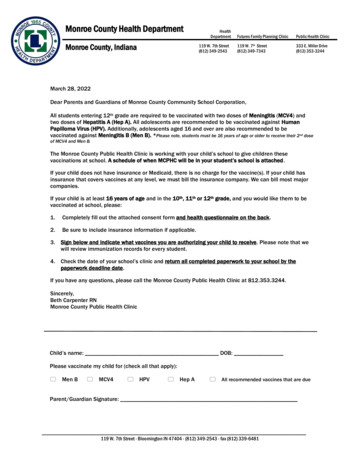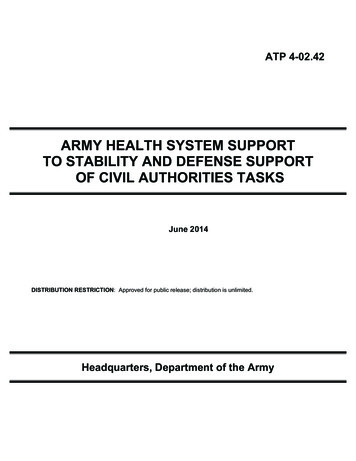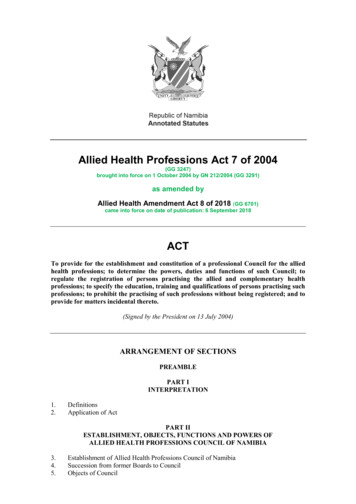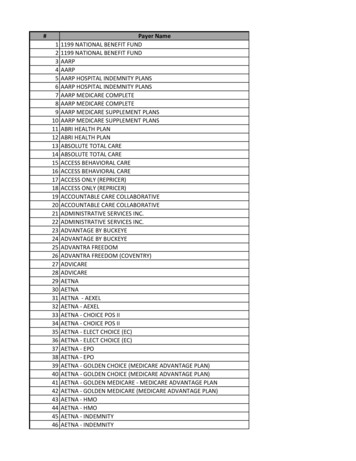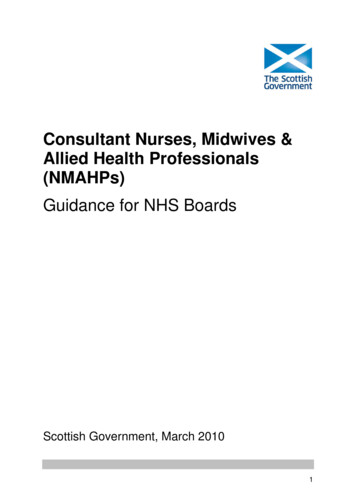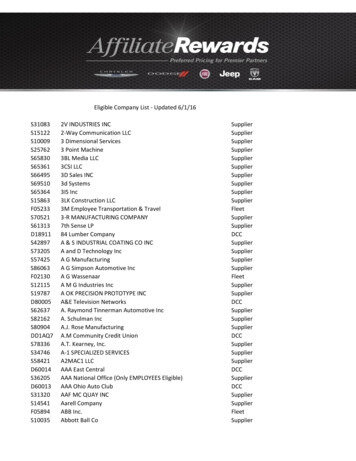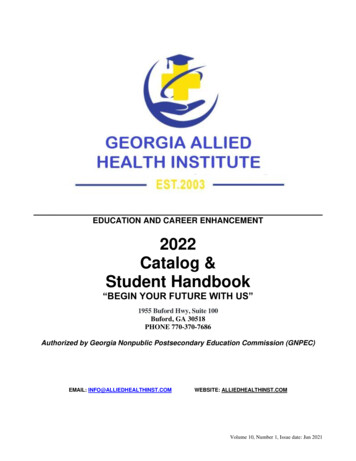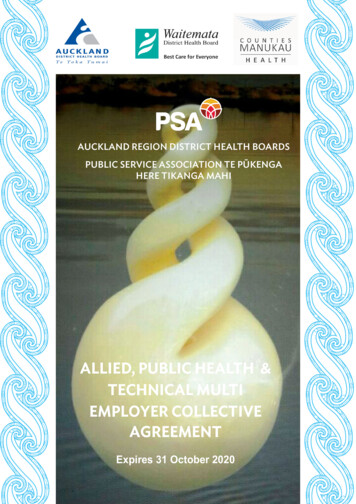
Transcription
AUCKLAND REGION DISTRICT HEALTH BOARDSPUBLIC SERVICE ASSOCIATION TE PŪKENGAHERE TIKANGA MAHIALLIED, PUBLIC HEALTH &TECHNICAL MULTIEMPLOYER COLLECTIVEAGREEMENTExpires 31 October 2020
Mauri mahi, mahi ora.Industry begets prosperity.He Mihi:E ngā mana, e ngā reo, e ngākarangarangatanga maha,Tēnā koutou, tēnā koutou,tēnā koutou katoa.No reira, nau mai haere mai,whakatau mai.Greetings to all, and you who havecontributed to this work.He WhakatauakĪ:Ehara taku toa i te toa takitahi,engari he toa takitini“Success is not the work of onebut the work of many”Attributed to Ngāti KahungunuThe pikorua is a traditional Māori pendant offriendship and growth.The watermark depicts two new shoots growing together,the joining of two cultures.
TABLE OF CONTENTS1.0AGREEMENT FORMALITIES . 51.1Parties . 51.2Coverage . 51.3Existing Employees on Individual Employment Agreements . 71.4New Employees. 71.5Partnership Agreement . 71.6Definitions. . 81.7Categories of Employment . 82.0HOURS OF WORK . 82.1Hours of Work. 82.2Overtime and Penal Time . 113.0CALL BACKS . 133.1Call-back occurs when the employee: . 134.0ALLOWANCES. 134.1On Call . 134.2Meal Allowance . 144.4Radio Practique Allowance . 144.5Home Dialysis Training Centre Allowance . 144.6Duly Authorised Officer & Care Manager Allowances . 144.7Clothing Allowance . 144.8Vision Hearing Testers (VHT) Smock Allowance. 154.9Dental Therapists - Additional Responsibility Allowance . 155.0REMUNERATION . 155.1Application of All Salary Scales . 155.2Allied & Public Health . 185.3Alcohol & Other Drug Clinicians . 205.4Health & Clinical Support Workers and Hauora Māori Workers . 225.5Psychologists. 265.6Management. 275.7Assistants . 275.8Technical . 295.9Salary Increments While On Study Leave . 525.10 Payment of Salary . 526.0ANNUAL LEAVE . 537.0PUBLIC HOLIDAYS . 558.0BEREAVEMENT/ TANGIHANGA LEAVE . 569.0SICK & DOMESTIC LEAVE . 5710.0PARENTAL LEAVE. 5811.0JURY SERVICE/WITNESS LEAVE . 6112.0LEAVE TO ATTEND MEETINGS . 6213.0LONG SERVICE LEAVE. 6214.0LEAVE WITHOUT PAY . 6315.0HEALTH & SAFETY . 6316.0ACCIDENTS – TRANSPORT OF INJURED EMPLOYEES. 6317.0UNIFORMS, PROTECTIVE CLOTHING & EQUIPMENT . 6318.0REFUND OF ANNUAL PRACTISING CERTIFICATE AND CERTIFICATE OFCOMPETENCY FEES . 64Auckland Region Allied/ Public Health/ Technical MECA2
COMPETENCY EVALUATION . 64INITIAL REGISTRATION COSTS . 64PROFESSIONAL ASSOCIATION FEES. 65PROFESSIONAL DEVELOPMENT, EDUCATION & TRAINING LEAVE . 66Performance Appraisal and Professional Development Plans . 6622.1.1Performance appraisal . 6622.1.2The allocation of professional development funds/ study leave. . 6622.1.3Where an individual application for professional development is declined . 6622.2 Training Plans. 6622.2.1develop a training and development plan covering PSA members. . 6622.3 Reporting Timeframes and Process . 6622.4 Existing Entitlements, Consolidated Funds and Scholarships . 6622.5 The parties acknowledge . 6722.6 Learning Representatives . 6723.0POLICIES AND PROCEDURES . 6924.0INSURANCE PROTECTION . 6925.0TRAVELLING EXPENSES AND INCIDENTALS . 6926.0 INDEMNITY INSURANCE . 7027.0 EMPLOYEE ACCESS TO PERSONAL INFORMATION . 7028.0 PAY & EMPLOYMENT EQUITY . 7029.0 SUPERANNUATION . 7130.0 WORKING BETTER TOGETHER . 7131.0 BARGAINING FEE . 7232.0 CONSULTATION, CO-OPERATION AND MANAGEMENT OF CHANGE . 7332.1 Statement of Intent . 7332.2 Management of Change . 7332.3 Participation. 7332.4 Staff Surplus . 7433.0 RETIRING GRATUITIES . 7734.0 ENDING EMPLOYMENT . 7834.1 Notice Period . 7834.2 Abandonment of Employment . 7835.0 HARASSMENT PREVENTION . 7836.0 EMPLOYMENT RELATIONSHIP PROBLEMS: . 7837.0 VARIATION TO COLLECTIVE AGREEMENT . 8138.0 SAVINGS . 8139.0 NON- WAIVER UNDERSTANDING . 8140.0 TERM OF DOCUMENT . 81Appendix A- Career and Salary Progression (CASP) Framework . 82Appendix B – Merit Progression . 96Appendix C - Merit Criteria. 102Appendix D– Degree Based Occupations Pay Spine . 105Appendix E- Medical Laboratory Scientists and Technicians - Definitions . 106Appendix F - Medical Laboratory Scientists & Technicians - Application of Minimum Steps 107Appendix G - Hauora Māori Worker – Assessment Process . 108APPENDIX H . 123Appendix I - Dental Therapy Provisions . 127Appendix J - Alternative Payment System . 134Appendix K Indicative Job Title Table . 13719.020.021.022.022.1Auckland Region Allied/ Public Health/ Technical MECA3
Appendix L: Counties Manukau Accrued Education Fund . 140Appendix M: Variations . 143Appendix N – Retiring Gratuities. 152Appendix O - Healthy Workplaces Agreement. 155Appendix P – National DHBs / PSA APHT Engagement Forum . 158Appendix Q – Sonographer Salary Scales. 159Auckland Region Allied/ Public Health/ Technical MECA4
1.0AGREEMENT FORMALITIES1.1PartiesIn accordance with the Employment Relations Act 2000 this collective agreement is made:Between:a)Auckland District Health Board,Counties Manukau District Health Board,Waitemata District Health Board,(hereinafter referred to as “the employer” or DHB)anda)1.2The New Zealand Public Service Association Te Pūkenga Here Tikanga Mahi Incorporated(hereinafter referred to as the PSA or the ‘union’)CoverageThis is a multiple employer collective agreement (MECA) and is made pursuant to the Employment Relations Act2000. This MECA shall apply to all employees who are members of the PSA and who are employed by the DHBsparty to this MECA in the following services and professions:1.2.1Public Health (salary scales 5.2; 5.4)Public health professionals provide services for the purpose of improving, promoting, or protecting public healthincluding preventing population-wide disease, disability, or injury; through—a)Health Protection services, which include regulatory functions; andb)Health Promotion services.1.2.2Technical/Scientific (including Food Supervisors, Hyperbaric Technicians & Vision Hearing Testers/Technicians) (salary scales 5.8)A range of technical or scientific positions that either:a)Provide clinical support services to clinicians who provide direct patient care; orb)Provide direct patient care; orc)Provide public health services.These positions can be supervised or non-supervised depending on the level of skill, education and qualification.1.2.3Health Assistant (salary scales 5.7)A health assistant works under the direction and supervision of an allied health, public health, technical/scientificprofessional or dentist.1.2.4Allied Health (salary scales 5.2)The allied health professions each have a distinct, specialised body of knowledge and skills, and actively workwith people accessing health and disability services across a range of settings. In their practice, allied healthprofessionals provide services and engage in activities that may include: prevention, assessment/evaluation,identification/diagnosis, treatment, rehabilitation/habilitation, promotion of health and wellbeing, education,research and health services management.To be part of the allied health professional workforce, health professionals must be:a)involved in direct patient contact providing patient treatment, intervention or assistance, assessment,patient management and education, working in primary, secondary and tertiary care settings;b)tertiary trained undertaking recognised university degrees at undergraduate and/or graduate entrylevel;Auckland Region Allied/ Public Health/ Technical MECA5
c)d)e)required to obtain specific qualifications to either obtain (or be eligible for) professional registration topractice, or to join the relevant professional association and have a specific professional qualificationrecognised by the New Zealand Qualifications Authority (NZQA);allied to each other and the medical, nursing/midwifery and technical/scientific professions, workingtogether as part of multidisciplinary or inter-professional teams to achieve best practice outcomes forthe client across the primary, secondary and tertiary health sectors; and‘allied’ with clients, the client’s family/whānau and other carers, and with the community in order toachieve best outcomes for the client.The parties recognise that historically, allied health professions have not always required a university degree asan entry point to the profession. This coverage clause is not intended to exclude employees who:a)do not hold a university degree but who have achieved registration with their regulatory authority; orb)hold a position for which the current requirement is to have a university degree and/or registration butwho does not hold that university degree.c)are involved in the training and development of other Allied Health Clinicians (e.g. Educators) but whodo not directly provide patient care as part of that role.For avoidance of doubt, the broad category of Allied includes employees employed as Psychologists in theprevention, assessment, diagnosis, intervention and treatment of children, adolescents, adults and families (andpaid on salary scales 5.5).1.2.5Alcohol & Other Drug Clinicians (salary scales 5.3)A health professional whose role is to provide assessment and intervention for those experiencing harm relatedto the use of alcohol & other drugs and those concerned about another person’s use.1.2.6Hauora Māori Workers, Health & Clinical Support Workers (salary scales 5.4):A range of positions that work in mental, physical and public health services. These positions may have some, ora combination, of the following elements:(i)a strong cultural element(ii)co-ordination(iii) clinical support(iv) assessment(v)advisory(vi) educating(vii) counselling(viii) facilitating1.2.7Allied Health/ Public Health/Technical Management Positions (salary scales 5.6)Management positions will only be covered if they meet the specific criteria outlined in clause 5.6.1.2.8Any other employees substantially employed in one of the above positions who may from time to timeuse an alternative title.1.2.9Nothing in the above coverage clause shall act to exclude any employee who is a member of the PSAand was covered by the 2005-07 regional MECA that preceded this agreement, nor shall it act to includeany employee whose position was explicitly excluded from coverage of the regional MECA thatpreceded this Agreement unless the PSA and the DHB concerned specifically agree otherwise.1.2.10Genetic Counsellors are excluded from coverage under this MECA.1.2.11Dental Assistants employed by the ADHB Greenlane Hospital and Middlemore Hospital are excludedfrom coverage under this MECA.1.2.12The parties agree that, where new or emerging roles are identified that either consider are within thegeneral ambit of coverage of this Agreement, but not specifically listed above or in Appendix K, theyshall work together to determine the appropriateness of coverage by the Agreement and, if so, the salaryscale(s) that should apply. Any outcomes shall be recorded by way of formal variation to this Agreementor through formal exchange of letter or memorandum.Auckland Region Allied/ Public Health/ Technical MECA6
1.3Existing Employees on Individual Employment AgreementsWhere the employee joins the PSA and their position is covered by this agreement that employee’s terms andconditions of employment shall, from the date on which they join the PSA, be those contained in this agreementunless otherwise agreed between the parties. The employer recognises that the employee has an entitlement toseek advice from the PSA in this regard.1.4New Employees1.4.1New employees who are members of the PSA and whose position is covered by this collectiveagreement shall be bound by this agreement.1.4.2New employees who are not members of the PSA shall be offered an individual employment agreement,which is based on the terms and conditions of this MECA for the first 30 days of their employment. Atthe conclusion of this 30 day period, the employee may elect to join the PSA and in doing so shall bebound by this collective agreement or remain on an individual employment agreement if they do not jointhe PSA.1.5Partnership AgreementPlease refer to the Agreement for a Bipartite Relationship Framework Appendix H.1.6DefinitionsOrdinary hourly rate of pay for 40 hours per week workers shall be 1/2086, correct to three decimal places of adollar, of the yearly rate of salary payable.Ordinary pay means the annual salaries provided for in this agreement. For part time employees, the annualsalary shall be pro-rated.Ordinary or normal hours mean 80 hours per fortnight.Duty/shift means a single, continuous period of work required to be given by an employee, excluding overtime,on-call and call-back. A duty shall be defined by a starting and finishing time. Duties shall be morning (AM),afternoon (PM) duties or night duties. When a major part of a duty falls on a particular day the whole duty shall beregarded as being worked on that day.Employee means any person employed by an employer and whose position is covered by this agreementEmployer means the relevant DHB employing the particular employee.Fortnight means the 14 days commencing midnight Sunday/Monday. When the major part of a shift falls on aparticular day the whole shift shall be regarded as being worked on that day.Penal rate is rate of pay for time worked (other than overtime) within ordinary hours of work during times specifiedin clause 2.2.Service means the current continuous service with the employer and its predecessors (Hospital and HealthServices, Crown Health Enterprises, Regional Health Authorities, Health Funding Authority, Area Health Boardsand Hospital Boards), except where otherwise defined in the applicable clause. From 1 November 2007 servicewill transfer between DHBs. From 1 November 2007 service shall not be deemed to be broken by an absence ofless than three months. However, where the employee remains actively engaged on related work to theirprofession or study whilst absent, the period of three months shall extend to twelve months. This period of absencedoes not count as service for the purpose of attaining a service related entitlement.Shift work is defined as the same work performed by two or more employees or two or more successive sets orgroups of employees working successive periods. A qualifying shift has a corresponding meaning.Auckland Region Allied/ Public Health/ Technical MECA7
T1 means the ordinary hourly rate of pay.T 1.5 means one and one half the ordinary hourly rate of pay.T 2 means double the ordinary hourly rate of pay.1.7Categories of EmploymentCasual employee means an employee who has no set hours or days of work and who is normally asked to workas and when required. Casual agreements shall not be used to deny staff security of employment. The employerreserves the right however, to employ casual employees where necessary to meet the demands of servicedelivery.Part time employee means an employee, other than a casual employee, employed on a permanent basis butworks less than the ordinary or normal hours set out in the hours of work clause. Any wages and benefits e.g.leave, will be pro rata according to the hours worked unless specifically stated otherwise in this agreement.Permanent employee means an employee who is employed for an indefinite term; that is, an employee who isnot employed on a temporary or casual basis.Fixed term employee as defined by Section 66 of the Employment Relations Act 2000 means a full time or parttime employee who is employed for a specific limited term for a specified project or situation or, for example, toreplace an employee on parental leave or long term accident or sickness. There is no expectation of ongoingemployment. Fixed term agreements shall not be used to deny staff security of employment.Full time employee means an employee who works not less than the ordinary or normal working hours set underthe hours of work clause in this agreement.2.0HOURS OF WORK2.1Hours of Work2.1.1Statement of IntentThe employer recognises the need for staff to balance their work life with their recreational and home life, and iscommitted to active participation in the management of workloads and working time that achieves staff andmanagement goals, and results in realistic work expectations. DHB’s and the PSA recognise that a degree ofstress is a part of the modern workplace. The employer makes a commitment to working with staff to developpolicies and practices that attempt to minimise the negative impact stress has on workers’ lives and that workloadsare reasonable.Nothing in this document is intended to vary the hours of work arrangement that apply at the time that this MECAcomes into force. The hours of work can only be varied by application of clause 2.1.7 including use of changemanagement processes.2.1.2The WeekThe week shall start and end at midnight each Sunday/Monday. When the major part of a duty falls on a particularday, the whole duty shall be regarded as being worked on that day. This provision does not relate to remunerationbut only to rostering conventions for days off.2.1.3Ordinary Hours of Worka)Unless otherwise specified the ordinary hours of work shall be either(i)Eighty (80) hours in each two week period (14 days), worked as not more than ten (10) duties,provided that for rostered shift work the ordinary hours of work may average forty (40) hours perAuckland Region Allied/ Public Health/ Technical MECA8
week during a period of up to seven (7) weeks, or the applicable roster period, whichever is thelesser; or(ii)Eighty (80) hours in each two week period (14 days), worked as not more than ten (10) dutiesbetween 0600 and 2000 hours, Monday to Friday, or(iii)Forty (40) hours in each week worked as not more than five (5) duties between 0600 and 2000hours, Monday to Friday.b)The ordinary hours of work for a single duty shall be up to a maximum of ten (10) hours.c)A duty shall be continuous except for the meal periods and rest breaks provided for in this Agreement.d)Except for overtime, and except where an alternative arrangement is operating, each employee shallhave a minimum of four (4) days off during each two (2) week period (14 days). Days off shall beadditional to a nine (9) hour break on completion of the previous duty.e)Except for overtime, no employee shall work more than five (5) consecutive duties before a day(s) off,provided that an alternative arrangement may be implemented by agreement between the employerand a majority (measured in full-time equivalents) of the directly affected employees.f)A range of hours are worked across the DHBs are defined as full-time.There is no intention, as a result of these negotiations, to change the existing ‘full-time’ hours of workin each DHB unless otherwise agreed.2.1.4Rostersa)The Health and Safety at Work Act 2015 requires the employer to ensure, so far as is reasonablypracticable, the health and safety of workers while at work.b)Therefore, in designing and implementing shift rosters to meet service needs, the employer shallensure the disruption, personal health effects and fatigue associated with shift work are minimised forthe group of workers involved. Roster templates and changes to roster templates shall be jointlydeveloped and reviewed by the employer, representatives of affected employees and the PSA.c)Where an employee is required to start and/or finish work at changing times of the day and/or onchanging days of the week, then a roster shall be produced.d)The roster period shall be four (4) weeks (28 days) or greater, except that it may be less for serviceswhere unpredictable service demands make this impracticable.e)Rosters shall be notified to the employees involved at least three (3) weeks (21 days) prior tocommencement of the roster period, except that the minimum period of notification for roster periodsof less than four (4) weeks shall be two (2) weeks (14 days). Less notice may be given in exceptionalcircumstances.f)Single days off shall be avoided as a routine rostering device, and there shall be no more than onesingle day off for an employee during a four (4) week period. Employees shall be discouraged fromrequesting single days off.g)Notwithstanding the foregoing conditions staff may be permitted to change shifts one with another bymutual arrangement and with the prior approval of the manager. Additional overtime or other penaltyprovisions shall not apply in these instances, i.e. the swapping of shifts will be a cost neutral exercise.h)For employees working on 4&2 roster the roster cycle shall be for a six week period, of four days onduty followed by two days off duty.Auckland Region Allied/ Public Health/ Technical MECA9
2.1.5Special ProvisionsFor fulltime dietitians at CMDHB only (whose annual divisor is 2086) the flexible hours of workarrangement set out in clause 4.2.2 of CMDHB collective agreement dated 30 June 2002 shall applyexcept that:a)Core hours (Monday to Friday) of 1000 to 1500 hours shall apply unless otherwise agreed with thedepartment manager.b)At least one person in the department is required to be rostered to be present (Monday to Friday) atthe beginning and end of each day outside of these core hours.2.1.6Hours of Work Requirementsa)The employer shall document the hours of work requirements for each position for which an employee,other than a casual employee, has been engaged or is for the time being fulfilling. The written hoursof work requirements shall be provided to the employee.b)Hours of work requirements shall comply with all of the provisions of clause 2.1.3 of this agreement.c)Hours of work requirements shall reflect actual hours of work and shall be specified in terms of:(i)(ii)(iii)2.1.7The times of the day for which an employee is required to be available for the ordinary dutyhours of work; andThe days of the week for which an employee is required to be available for the ordinary weeklyhours of work; andAny overtime or on-call requirements or opportunities.Variation of Hours of Work Requirementsa)Emergencies.The employer may require variat
A health assistant works under the direction and supervision of an allied health, public health, technical/scientific professional or dentist. 1.2.4 Allied Health (salary scales 5.2) The allied health professions each have a distinct, specialised body of knowledge and skills, and actively work

